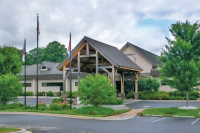Architect mix-up over HCC project begs the question: can water run uphill?
Haywood Community College has hit a nearly $227,000 roadblock during the construction of it new creative arts building.
The $10.2 million building — a controversial project to begin with — will tap into contingency funds for the project to pay for previously unforeseen gaps in the architect’s plans. Contingency money is built into the price tag at the beginning of a project in case added costs arise.
“The reason you have a contingency is in case something crazy happens. That is the whole point,” said Bill Dechant, director of campus development. Dechant was hired recently as an in-house architect, a common position at state universities with nearly constant construction project but a somewhat new trends at the community college level.
The $226,901 expenditure will pay for the purchase of a new water pump and an outdoor shed to house the mechanism.
It became apparent in July that a pump would be needed to create sufficient water pressure for the building’s sprinkler system.
The architect firm hired to design the building had their engineers test the pressure in water lines on campus during the planning phase. The problem, however, is the pressure was tested down the hill from where the new building is located, Dechant said.
As water flows up the hill to the new building, it loses pressure, a fact the architect did not factor into his plans, Dechant said.
“Anyone who works in the mountains know if you take water pressure (at the bottom of the hill) and it has to go uphill several hundred feet, it is not going to be the same,” Dechant said.
Dechant explained the problem to county commissioners at their meeting this week, as county commissioners ultimately would have to sign off a change order to tap into the contingency funds.
Commissioner Kevin Ensley agreed that Raleigh-based architect Mike Nicklas should have taken the hillside position of the building into account.
“It is just common,” Ensley said. “It is always good to have an architect that is familiar with mountain construction.”
If the problem is not fixed, the building cannot open. All structures are required to have functioning sprinkler systems.
“Time is of the essence,” Dechant said. “This change order really needs to move.”
Even if the problem had been included in the project’s blueprints originally, the county would end up paying a similar amount for the pump at the beginning rather than on the backend.
Commissioners queried how the current added cost was tabulated.
The general contractor submitted five proposals before a price was settled on.
“We have been through several iterations of this design,” Dechant said.
The college negotiated a $100,000 decrease from what the contractor originally sought.
“We have about massaged this as much as we can,” Dechant said. “It is about as economical as we think we can do.”
Commissioners approved the change order but questioned how the oversight could have happened.
“Why wasn’t this done at such time the design would have accommodated this?” inquired Mark Swanger, chair of the county commissioners.
“That’s my question,” chimed in Commissioner Bill Upton.
The community college is currently trying to find out how such a costly slip-up occurred.
“We are in the process of trying to figure out who really drop the ball,” Dechant said. “The college feels like we are not responsible for that, that this is a design error. We are going through the correct procedures to solve that and figure out where responsibility lies.”
At the end of the job if there is evidence that the architect was negligent, Dechant said, the college would negotiate that at the end of the contract.
What is the outside architect saying about the bungle, asked Commissioner Mike Sorrells.
In the architect’s defense, he thought that a campus-wide water improvement project carried out last year would remedy any water pressure issue the the creative arts building might have, Dechant said.
Both the college and the architect plan to submit summary statements — their own version of events — to the state construction office.
Prior to the snafu, the college had a contingency budget of more $600,000. If the project changes are approved, the budget will drop to $365,198.
Dechant could not promise the commissioners that this would be the last of the change orders.
“I am sure there will be small change orders that come along. There always are,” he said. “I don’t think there will be any more change orders of the significance we are talking about. That said, I would never stand up here and guarantee anything.”
For community colleges, approving change orders can be a lengthy process. First, the project managers must get approval from the college’s Board of Trustees before presenting the issue to the county commissioners. The last step is to apply to the state construction office for permission to change a project’s costs and parameters.
Dechant said he did not know how the county or college would spend any remaining contingency funds if they go unused.
In addition to the cost of the water pump itself, the college may end up shelling out more funds in overhead costs to the contractor, who said construction will be delayed because of the error. If the contractor can prove that the change order held up construction, then HCC will pay more than $1,000 for each day that the construction schedule extended beyond what the workers were require to do.
‘Biggest project we’ve ever undertaken’
The commissioners and college administrators battled for months about the scope of the creative arts building project. Commissioners insisted that the college slash the price of its plans, while administrators argued that the building construction and amenities had been whittled down enough already. The new facility will house studio and classroom space for students studying the creative arts, such as pottery and woodwork.
Both groups eventually settled on the current $10.2 million cost. Money to pay for the new building is coming from a quarter-cent sales tax approved by county voters more than four years ago to fund improvements to Haywood Community College’s campus.
“This is the biggest project we’ve ever undertaken at Haywood Community College,” Dechant said. Construction of the building, which is still expected to conclude in early May, is about halfway complete.
The building will feature a number of green initiatives, including rainwater harvesting, solar thermal energy and Energy Star photocopiers.
Haywood construction industry fell 34 percent in recession
During the past decade, Haywood County’s economy has seen some ups — but mostly downs.
A presentation given at the recent Haywood County Economic Development Commission meeting offers a glimpse of how the county fared before and during the recession. The decade worth of numbers presented shows drastic declines in employment and growth but little or no rebound since.
Research economist Tom Tveidt, of SYNEVA Economics in Asheville, was commissioned to do an economic trends study for Old Town Bank based in Waynesville. The study is now being shared with the community.
Sectors impacted the most by the recession were construction, manufacturing and wholesale trade. The number of construction jobs declined 34 percent during the recession, and demand for second-homes in the mountains withered. Wholesale trade and manufacturing slid by 37 percent and 13 percent, respectively.
On the bright side, manufacturing and wholesale industries have begun growing once again though have yet to bounce back completely.
Total employment in the county tumbled from almost 27,000 jobs in 2008 to about 24,850 in 2009. Employment numbers have continued to fluctuate during the past couple year but never reached more than 25,600 jobs.
The sustained decline in job opportunities may have affected Haywood County’s population numbers as well.
“That explains the people leaving,” said Kevin Ensley, a member of the Economic Development Commission after seeing the decline in jobs. Ensley is also a Haywood County Commissioner.
Haywood County residents have a little extra room compared to a couple years ago.
Its population saw a decline of a little more than 200 people in 2010, bucking an almost two decade long trend of population increases. Last year’s drop in population was the county’s first decline since 1990.
Despite the recent drop, Haywood County’s population grew by 4,802 people during the first decade of this century, and the county is ranked 55th in the state for growth.
County residents are also getting older though.
As a popular location for retirees and second homebuyers, Haywood County has historically had an aging demographic. But, in 2010, the majority of resident were reportedly in their 50s or 60s, compared to just 10 years ago when most were in their 40s and 50s.
County governments receive state and federal funding based on their projected economic and population growth. The predictions are based on past growth, such as the number of building permits issued.
Prior to 2008, the county issued an average of 32 building permits each month. That number dropped to 13 after 2008.
Haywood County has benefited monetarily from estimated growth projections in the past.
“We get over ranked” and receive additional money because the number of second homebuyers who either purchase or build homes in the county, Waynesville Mayor Gavin Brown said.
2000-2010 Population
Increased 4,802 or 8.6%
2010 population decreased 217
First decline since 1990
Total employment from 2008 to 2009
Almost 27,000 down to 24,850
Average building permits per-month
Pre 2008: 32; Post 2008: 13
With construction down, Haywood Home Builder’s struggle to stay viable
While the construction industry, the Haywood Home Builders’ Association is giving itself a makeover, one it hopes can keep them afloat and the doors open.
With home building still flagging, membership has been steadily declining, and instead of waiting on the ship to right itself, they’re beginning to realize that if the economic paradigm has shifted, maybe it’s time to shift with it.
“We have no choice,” Home Builder’s President Jim Howell said frankly. “We’re going to have to change and think outside the box.”
For the home builders, it’s a particularly salient lesson. In a bust that centered around real estate, the folks who build that real estate are going to take a pretty hefty hit.
If you’re looking at unemployment numbers, said Howell, go ahead and double them, and that’s what kind of unemployment you’ll find in the construction sector.
So, unsurprisingly, their membership has dropped — from just more than 200 at the height of the building boom to only 130 members now. The Haywood County Board of Realtors has likewise seen a drop in membership — from 430 Realtors in the county in 2006 to only 261 today.
Given the decline, the Haywood County Homebuilder’s Association isn’t certain it can keep its doors open.
“That’s something that could happen,” said Howell, when asked about the prospect of shuttering the association. “With the current loss of members, it’s very realistic. It could happen in the next year very easily.”
Howell is trying to change the body’s course while he’s at the helm.
They’re focusing efforts not only on how to maintain viability with a smaller membership, but also how to retain those members and give them the services they need in a changing market.
“We’re trying to change the format of our meetings, turn them into social events,” said Howell. “When you are in a business-style format, it’s pretty restricted.”
They’re also looking to other fundraising options, like an iPad raffle they’re holding and a shootout fundraiser planned for the summer.
They’re trying to get more involved in the community, as well, joining with groups like the Board of Realtors and the Chamber of Commerce to bring in more support, better networking connections and hopefully share the burden of a diminishing economy.
And they’re not the only ones who are looking towards changing their tactics.
The Haywood County Board of Realtors has been discussing a merger since last year with the Board of Realtors in Asheville, Henderson and Transylvania. The merger would help lessen the blow of a deflated real estate market by creating one large umbrella board that would help spread costs and consolidate benefits.
When the proposal was first floated to Realtors earlier this year, Lisa Brown, the board’s executive, said they were open to what was best for members, and with such a slip in membership, it’s hard not to see banding together as an enticing option.
“We saw strength in numbers, we could give more services to our members,” said Brown. “So let’s sit at the grown up table, let’s hear the proposal let’s see what’s in it for the association.”
The downside may be less of a local focus in Haywood, however.
Readjusting to a new kind of real estate economy isn’t going to be easy for organizations like Brown’s and Howell’s. But Howell believes that now, more than ever, they can offer their members connections and support that they’ll desperately need going forward.
Recognizing the new and different needs of the county’s homebuilders in today’s climate will be the key to any future success.
“I don’t think the building boom will be as big as it was,” said Howell. “I think we outgrew what we could afford to do, not only as an industry but as a nation. We were too busy living the American dream to sit down and figure out what we could afford.”
In a report released this week, the National Association of Home Builders noted a slip in builder confidence for the month of April. Every month, they do an assessment of home builders across the country, polling them both on the work they have and their confidence in future prospects.
While some parts of the country showed upticks in both jobs and confidence, the South went down.
However, in Haywood County, the construction industry is showing signs of a rebound, albeit a slight one. At the very least, things are leveling off, based on the number of building permits being issued.
And that would be good new for the entire county.
“Anything that happens in the building industry affects every business in this area,” said Howell. “If we’re not working, a lot of people are not buying hamburgers.”
By the numbers: Haywood construction permits
The construction industry has been on the decline witnessed by the decrease in all building permits issued in Haywood County. These numbers includes all permits for residential, commercial, new construction and additions.
2006 753
2007 772
2008 499
2009 388
2010 416
* These numbers do not include Waynesville and Canton, which issue their own permits. Building permits for Maggie Valley are included for 2010, but not previous years. Maggie quit administering its own building permits due to a decline in volume with the recession.









